
Pain After Root Canal Treatment
Most people indicate that toothache is the most unbearable, dramatic, and undoubtedly the worst pain they have ever dealt with after labor pain, of course!
The excruciating pain that numbs your nerves makes you unable to talk and just rush to the dentist.
Mostly in such instances, the dentist will perform a root canal treatment for you. After the procedure is over, you head back home, relaxed and assured that the pain will not return. You promise yourself regular dental checkups to never face such blinding pain again.
But slowly and steadily, the pain surfaces again. The same trauma, and again you visit your dentist, more discouraged this time.

Is it a stage of recovering from root canal treatment?
You question him, how is this possible?
Well, there are a multitude of reasons for that!
Firstly dental pain is a typical onset after an RCT treatment. Minor sensitivity and discomfort are not an unusual incident. However, if the pain resides for more than a week, then you have a reason to worry about it.
The ‘return of your pain’ may be due to a variety of reasons.
Post-operative pain can be irksome for both the patient and the dentist.
The goal of endodontic treatment is to seal the tooth to avoid the entry of bacteria. Pain and flare-ups ( inflammation after an endodontic procedure) are commonly experienced in many patients.
However, severe pain after root canal treatment can be a sign that all is not right.
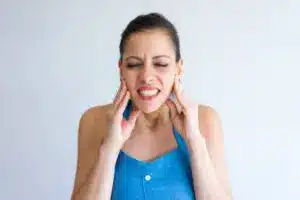
An integral part of endodontic treatment is the prevention and management of any post-operative pain.
Studies reveal that the frequency of severe pain after RCT ranges from 1.4% to 16%. It may go up to even 50%
Fact- The degree of preoperative pain majorly dictates the occurrence of your post-operative pain!
Reasons for severe pain after root canal treatment
Tooth pain after root canal treatment can further be subcategorized into;
- Chemical factors-
-
Overextended filling material–
Overfilling the material in the canal induces irritation to the tissue. It also hinders the repair of the periapical tissue( tissue surrounding the apex of the tooth).
Another problem caused by overextended filling is when it hits the opposite tooth with constant force. In this case, your dentist has to remove the ‘high points’ of the tooth.
-
Irrigants-
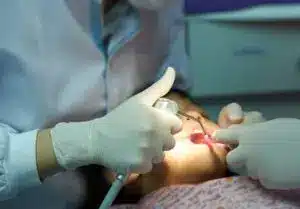
The standard irrigant used by dentists during an RCT treatment is sodium hypochlorite. It has antimicrobial properties that help in cleansing and disinfecting the root canal. In rare cases, the solution may leak out and reach your root tip, causing you pain.
-
Intracranial medicaments-
There has been worldwide use of calcium hydroxide as a medicament during endodontic treatment. Calcium hydroxide has the caliber to inactivate the bacteria that are infesting in your root canals.
However, the researchers now believe that patients given calcium hydroxide during the treatment show aggravated pain levels after the procedure.
-
Mechanical factors
-
Missed canal
The canals present in the tooth are incredibly minute. They can be challenging to detect, especially the ones of the molars.
There is a possibility that the dentist may overlook one of these infected canals, leaving behind a few nerves or a pocket for the bacteria to enter.
After the procedure, you might feel sensitivity to hot and cold as it was preoperatively( if nerve endings are left behind). In case of bacterial infection, there will be pressure sensitivity.
-
Infection in lateral or accessory canals
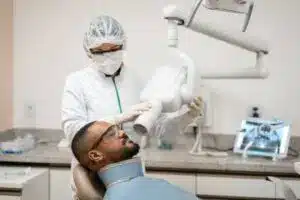
The curved and narrow canals that branch out of the primary root canal are the accessory or the lateral root canals. During the procedure of RCT, these canals are challenging to detect due to their minute and complicated network of branches. If your dentist suspects an accessory canal, he may go for a more detailed CBCT test instead of the standard X-ray to detect the presence of these canals.
If the infected accessory canals are overlooked and not cleaned, this may cause postoperative pain.
-
Extrusion of debris
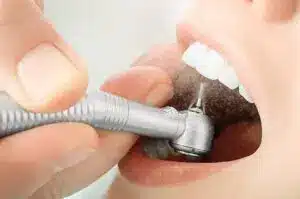
Endodontic instrumentation can cause the extrusion of debris in the apical region(dental shavings, microorganisms that accumulate in the root apex during the shaping of the canal).
Studies revealed the real cause of the inflammatory reaction is due to the instrument design and the type of movement done.
-
Infection in root canal
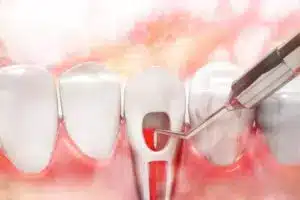
At times, the filling might leak, allowing the bacteria in your saliva to infest the edges of the filling. When the bacteria makes its way inside the root canal, an impending pain is caused within a few days after the procedure.
-
Cement or air present in the root tip
Due to overfilling of the material, the cement may ooze out of the root tip.
If before the RCT treatment, the root tip was not infected, the settling of the cement now will cause pain.
In rare cases, air may be forced down into the root tip, causing pain and pressure.
-
Over instrumentation
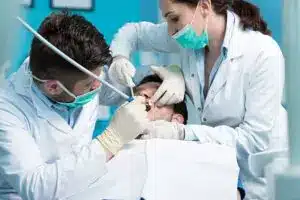
Inflammation may occur as a result of the root canal files. If the dentist pokes the area way beyond the tip of the tooth or if the file breaks and gets lodged in the canal, this can be a cause of pain.
Also, if the surrounding tissues are traumatized with the use of the instruments, an inflammatory reaction is a common sign. A good dentist, however, does everything in his control to prevent this situation.
-
Improper removal of pulp
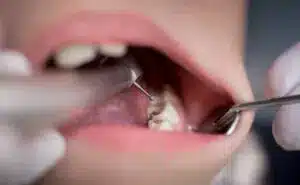
A standard root canal is 15 mm to 25 mm in length. However, some canals may be as deep as 30 mm. Reaching such levels can be difficult and needs the help of special instrumentation. If your canal is treated short of its actual length, then the diseased pulp is not entirely removed, and since the sealant is applied directly over it, this might be why few patients register pain.
-
Microbial factors
Microorganisms are regarded as the most common cause of pain after an RCT treatment because flare-ups mainly occur in necrosed tissues rather than in vital cases.
A few other factors responsible for pain are
-
Gender

Women are considered to suffer from post-endodontic pain more than men. Studies show that female patients are more sensitive to receiving a root canal treatment. The reason is due to the difference in fluctuating hormones like cortisol, and serotonin.
-
Type of teeth
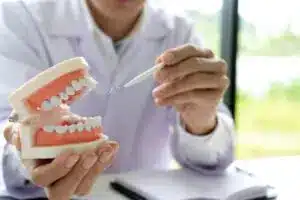
The incidence of pain after RCT is higher in mandibular( lower jaw teeth) than in maxillary teeth( upper jaw teeth).
This happens as the mandible has a lower density trabecular( interconnecting plates found in spongy bones) pattern, causing reduced blood flow, more localization of infection, and delayed healing patterns.
-
Negligence of patients

It is of immense importance that proper oral hygiene is maintained after an RCT treatment. All the advice given by the dentist has to be followed precisely. If oral health is not maintained, there is a chance of postoperative pain due to bacterial infection again.
Another potential cause of pain is when there is a crack in the RCT tooth. After the procedure, the tooth in which the RCT has been done is quite brittle as the blood supply to the tooth has been filled in. If caution is not taken and there is a forceful impact on the tooth, then a crack may develop.
-
Talk to your dentist!
Facing the same dilemma of pain postoperatively can be very apprehensive. It is essential on your part to maintain good oral hygiene and follow all the said advice of your dentist.
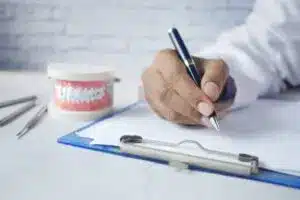
When it comes to the mechanical fault of a dentist, you can now put all your worries aside because, at Cosmodontist, we make sure that you do not have to face the same pain again.
